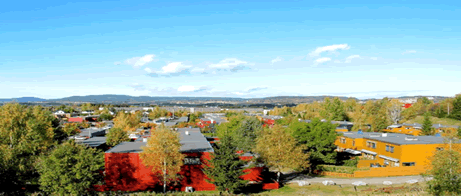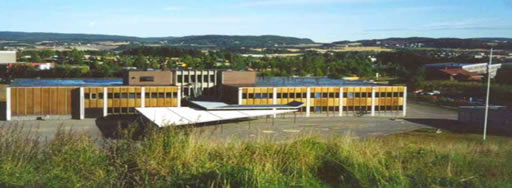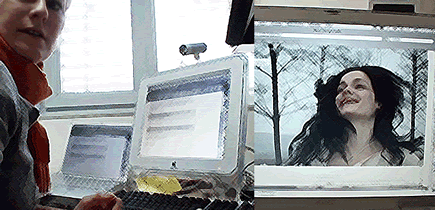Conclusion
Gail E. Hawisher, Cynthia L. Selfe, Patrick W. Berry, and Synne Skjulstad
Paper collage meets Photoshop: Synne and her artistic explorations. Click on image to see a video of Synne's
description of her composing process <transcript>.
-
Home
-
Introduction
-
Chapter 1: Digital Literacies, Technological Diffusion, and Globalization
-
Chapter 2: Digital Media & Transnational Connections: From Sarajevo, Bosnia-Herzegovina, and Sydney, Australia
-
Chapter 3: Cultural Designs for Writing Digitally: From Urbana, Illinois, and Afar
-
Chapter 4: Acts of Translation in the Academy and Across National Boundaries
-
Chapter 5: Global Digital Divide: From Nigeria and the People's Republic of China
-
Conclusion
-
Resources
CONCLUSION: Synne Skjulstad
From her online alphabetic literacy narrative, we learn that Synne Skjulstad was born on July 2, 1973, in Bergen, Norway, and that she and her parents, along with her older sister, moved to Oslo shortly after she was born. For the next 18 or so years, she lived with her family, which also came to include a younger brother, in Skjetten, an area just outside Oslo, before moving back to Oslo in 1992 to attend the university.
Synne grew up in Skjetten, right outside of Oslo, a place she describes as having "square houses, which are identical except for the color."
The first fully assembled personal computer was not to make its appearance and become mass-produced until 1977, but Norway itself was fast learning that it had tremendous oil resources that would come to provide remarkable economic growth to the country, growth that has lasted until this day (Ministry of Petroleum and Energy, 2010).
Both of Synne’s parents went to college, with her father becoming an engineer and her mother an elementary school teacher. Despite her mother’s being a teacher, Synne was often bored with the traditional offerings at school: she attended the local elementary and junior high in Skjetten, but decided to go to an alternative high school that was more than an hour from her home. As she tells it:
“…I was really bored with going to regular schools, so instead of going to high school, like most of my classmates, I went to a school where they were teaching drawing and tailoring, and I attended that school for a year instead, which I really enjoyed.”
She loved the school, with its nonacademic focus, and thought the building itself lovely:
"The school building was an old white-painted wooden building from the late 17th century, located in a field with apple trees. It was such a beautiful place, and I really enjoyed all the creative subjects we had (except for construction drawing, which I hated)."
After a year at the special school, Synne completed her high school studies near her home at a more traditional secondary school in Lillestrøm and then entered the University of Oslo, where she studied art history, psychology, and media studies. She continued with media studies in graduate school and in 2000, just as the Web was becoming a global phenomenon, submitted a collaborative master's thesis in which she and her coauthor, with additional collaborative help from two graduate students in informatics, created a hypervideo system and produced an interactive documentary film about the likes and dislikes of 41 Norwegians. Although Synne had no experience with computers while growing up except for using them to play games with her much younger brother, her interest in art and all things creative led gradually to her involvement with computers. But some of her early school experiences had allowed her to engage in what we might today call "multimodal composing"—that is, producing and distributing texts using a combination of visual and verbal elements such as the alphabet, photographs, video, color, animations, and sound. As she relates:
"We had a teacher in junior high school [whom] I really liked. She showed us images from Versailles, and we were supposed to use the images as inspiration for a project where we could collaborate on making a sound-based story where we played different roles. We could also make drawings as a part of the project. I really loved teachers who gave us the freedom to be creative."
She also relates repeatedly how much more drawing and multimodal composing meant to her growing up than writing:
"I wrote a diary in some periods, but I tore [my diaries] apart, and threw them away when they were written out. I was always afraid that somebody could read them. Instead of writing, I liked to draw, or to make silly radio shows with a friend. We used to improvise, and record it to a cassette."
Other teachers also supported her interests. She writes, "[My high school teacher] gave us the opportunity to make short films on video, and to spend great amounts of time on doing various projects. I really enjoyed his classes a lot."
When asked what her high school looked like, she wrote back and said:
“Instead of trying to explain the ugliness of the school,
I found this image on the Internet.”
The English language played a prominent role in Synne's schooling, and she began learning English when she was about 10. As Hilde Corneliussen, a participant in Jan Holmevik and Cynthia Hayne's (2000) study writes, "When in Norway, English is in the air" (p. 120). Synne might well agree; she tells us:
"There were English lyrics in the music I grew up with…and I remember listening to English without being able to understand much, singing versions of it like [The Beatles' "She Loves You"] 'sloves ju jejeje' and [The Beatles' "Yellow Submarine"] 'weali in e jellosummari' without having a clue about what they were singing about."
Synne also points out that since there are only approximately four and a half million Norwegians globally, English is very necessary for Norwegians who want to communicate with the wider world. It was not until she was well ensconced in the university, however, that she moved her penchant for multimodal composing online. She never liked Word, which she learned on a PC, but Photoshop means a great deal to her. As she states:
"When I learned how to use Photoshop, I really reconsidered my attitude towards computers, and started to look upon them as tools I could use creatively. I also learned how to use scanners, and I would make small collages, which I built inside the scanner with bits and pieces of torn magazines and other objects."
The image featured next to Synne in the banner at the top of this page is an early example of her work with a drawing program on her old personal computer. She says that it was the only work at the time for which she liked to use the computer. As we mentioned, Synne and three other graduate students—two from media studies and two from informatics or computer science—did go on to create a collaborative and interactive master's thesis, something that's not always so easy to accomplish and have accepted for an advanced degree in the humanities, despite collaborative work's being increasingly prized on digital media projects. The image is actually a representation of the hypervideo system the four created in 2001, a time when terms like "hypertext" and "hypermedia" were very much at the forefront in discussions of digital media productions (Bolter, 2001).
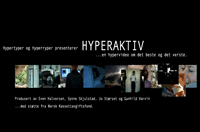 |
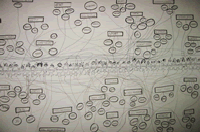 |
Scenes from HYPERAKTIV, a hypervideo system (Skjulstad & Varvin, 2001).
Click on each image to see an enlarged version.
Synne tells us:
"This image (above right) shows the structure of the hypervideo system. We had great fun translating our very technical drawing into the people who participated in it, and all the topics relating to the various people. We hung this huge diagram on the wall on a conference in Copenhagen, where we presented the project."
In the years since Synne completed the collaborative hypervideo project, she has continued with her research and design work. As she noted in her literacy narrative, she writes about Web design, "especially dynamic interfaces, often created in Flash, and often with an alternative twist to how the interfaces look and work."
She has also been "researching moving images on the Web, controversial websites, and research mediation online." Some of the ways in which new media practices make their way into almost every area of Synne's 21st-century life become apparent in the following videos that she created for this research.
In viewing her writing process video, which appears in the opening banner of this page, we see the extensive preparations for writing that attend Synne's process, which look familiar in that they're similar to our own and those of the coauthors who hail from very different parts of the world. Some writing habits and processes seem to cut across multiple cultural settings and include such tinkerings as positioning the lighting and laptop just right, finding a comfortable chair or couch, and making sure that all is in order before the writing begins (Prior & Shipka, 2003). With alphabetic writing, processes might include sharpening pencils precisely and finding the perfect yellow legal pad upon which to write; with digital writing, choice of software and font and a desktop we've arranged to perfection might also come into play.
In the next short video that follows, Synne illustrates a bit of the process through which she herself studies the Web and its interfaces. The study she's undertaken in the video also became part of her dissertation, entitled Mediational Sites: A Communication Design Perspective on Websites (2008). She was able to send the video material through YouSendIt, an online file-sharing software program that, like Dropbox, can be used in the service of research.
Click on image to view a video of Synne discussing her
research of Web interfaces <transcript>.
Although Synne was born before personal computers became a global phenomenon, she demonstrates here, as did many of the individuals from the U.S. in Literate Lives (2004), the rather privileged position she occupies in regard to opportunities available to her through the surrounding cultural ecology. The established school system in Norway enabled her to make choices not only in the variety of schools that she might attend, but also in the kinds of assignments with which she engaged. In another time and place, Synne's penchant for valuing those school activities that fell outside traditional academics might not have supported her eventual interest in university studies within the digital realm. But she, like many in this study, was able to exert her own powerful agency while living within a cultural ecology that allowed her to do so. She was, for example, permitted to change schools as a high school student to work in a more vocational environment and then to return from the vocational school a year later and earn credentials for the university from her original high school.
Though she persisted in valuing school activities that leaned toward multimodal productions, Synne's love affair with the digital was not immediate. Like many of us, she was able to gradually develop some expertise with digital technology with help from others, but learned to appreciate the versatility of computers only when Photoshop became a possibility for her to use in her work. As she explains:
"I have been involved in several multimedia projects. The first multimedia project I took part in was a course at the University of Oslo…. We were a group of five people, collaborating to develop a website connected to the museum of the explorer Thor Heyerdahl and his Kon-Tiki rafting expedition to Easter Island. Most of the people in my group got along very well, and we had an amazing time. I discovered the Macintosh, Photoshop, and the Web for the first time, and found it all really interesting. We divided up the various tasks, and I had the role as graphic designer most of the time. I spent days and nights in front of the computer, totally obsessed with the possibilities in Photoshop, making all kinds of collages and illustrations. Unfortunately, I have lost all the files from this project, and I think is a pity that I probably left them on a long gone floppy disk."
As Synne's narrative illustrates, collaboration has been central to Synne's multimodal projects since before she worked with computer technology. When asked how she sees herself using computers in the future, she replied:
"I see myself using computers even more in the future than I do now, which makes it even more important for me to do other things which don't have anything to do with computers at all…. The question is almost becoming what I don't use the computer to do. Horse riding, for example?"
This response should not surprise us, although we wonder if computing has not made its way into the saddle. As handheld computing becomes increasingly pervasive, it is not difficult to envision Synne riding across the Norwegian countryside while checking phone messages or Facebook postings on her iPhone.
With Synne as coauthor on our early transnational work (Hawisher, Berry, Selfe, & Skjulstad, 2006), then, we began to see how a combination of alphabetic text, video, sound, and still images might support research approaches that embrace a wide variety of digital media to explore individuals' literacy narratives and literate lives. This reliance on multiple digital resources—along with a methodology that prizes the words, thoughts, and images that coauthors create and offer—underscores, for us, the importance of multimodal, feminist approaches to research.
As we go forward, seeking to expand on the research approaches presented here, we might consider strategies that complicate current studies that take digital literate lives into their purview. We call for research that not only relies on life history interviews to explore the acquisition of digital literacies, but makes use of multiple modalities (video, audio, photography, animation, etc.) to conduct these studies. We would also like to see more research set in global contexts with an eye toward understanding people and learning from them, exploring the composing modalities that young people and adults call on when they engage the literacy practices they value and employ in digital environments.
In their book Qualitative Inquiry (2005), George Kamberelis and Greg Dimitriades make an observation about the development of a research methodology that we find particularly cogent. Referencing Denzin and Lincoln's description of qualitative research as a series of historical moments, these authors write:
"The seventh moment [in the development of research methodologies] is the 'future,' which…will be increasingly motivated by concerns with local histories and struggles, ethics, politics, and praxis… [in which] inquiry…[will] be more performative, both in the field and in the ways in which research findings are communicated" (Kamberelis & Dimitriadis, 2005, p. 8).
We suggest that digital media tools can help with efforts to both capture and convey this research of the future.
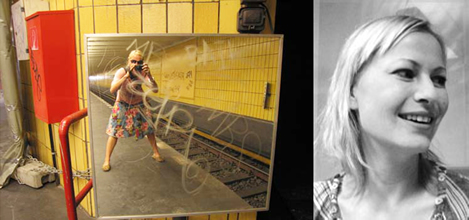
Synne: inspiring our use of digital media tools for research

